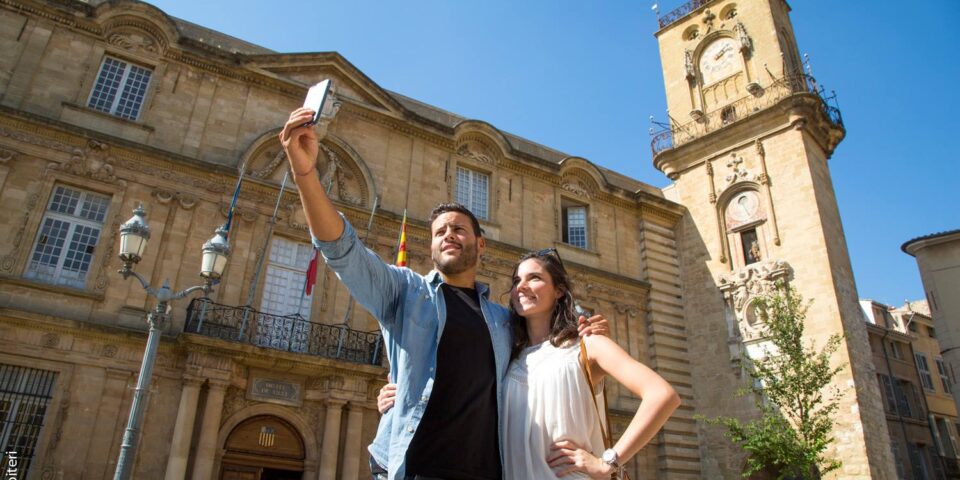- Franck Wagner
- The best of France and its regions, Provence Alpes Côte Azur, Provence Alpes Côte Azur, Your guide: a committed professional
Things to do in Aix en Provence : Our best tips !
Located in the south of France, Aix-en-Provence is a captivating city that offers a harmonious blend of history, culture, and natural beauty. Let’s dive into what makes this city so special.
Aix-en-Provence, often referred to simply as Aix, has a rich and vibrant history dating back over 2,000 years. Founded by the Romans in 123 BC, the city has seen the rise and fall of empires, the influence of various cultures, and the imprint of countless historical events. This heritage is beautifully preserved in its architecture, narrow winding streets, and charming squares.
One of the most iconic landmarks of Aix-en-Provence is the Cours Mirabeau, a wide avenue lined with elegant mansions, cafés, and shops. Strolling along this picturesque boulevard, you’ll feel the essence of the city as you pass by beautifully restored fountains, plane trees providing shade, and bustling terraces filled with locals and visitors enjoying their time. It’s the perfect place to soak up the vibrant atmosphere of Aix.
The city is also renowned for its stunning architecture, with a mix of styles ranging from Roman to Gothic to Renaissance. The Cathedral of Saint Sauveur is a true masterpiece, combining Romanesque and Gothic elements, while the Hôtel de Ville (City Hall) showcases the elegance of the 17th-century architecture. Don’t miss the opportunity to visit the private mansions known as “hôtels particuliers,” such as the Hôtel de Caumont and the Hôtel de Villepin, which have been converted into museums and cultural spaces.
Aix-en-Provence is also famous for its association with the renowned painter Paul Cézanne. Born and raised in Aix, Cézanne found endless inspiration in the landscapes and the light of the region. The Cézanne Route allows you to explore the places that influenced his art, including his family home, Jas de Bouffan, and the iconic Montagne Sainte-Victoire, which appears in many of his paintings. A visit to the Atelier Cézanne, his art studio preserved exactly as he left it, is a must for any art lover.
When it comes to culture, Aix-en-Provence is home to several prestigious festivals. The Festival d’Aix-en-Provence, held every summer, is one of the most renowned opera and classical music festivals in the world. It attracts top performers and artists from around the globe and offers a diverse program of performances in stunning venues throughout the city. The Festival International de Piano is another highlight, celebrating the art of piano playing with a series of concerts and recitals.
Here are our best tips to enjoy Aix en Provence and its surroundings.
Things to do in Aix en Provence : book your Tour with a specialist !
Have a walk through the old city : The Cours Mirabeau and the medieval district
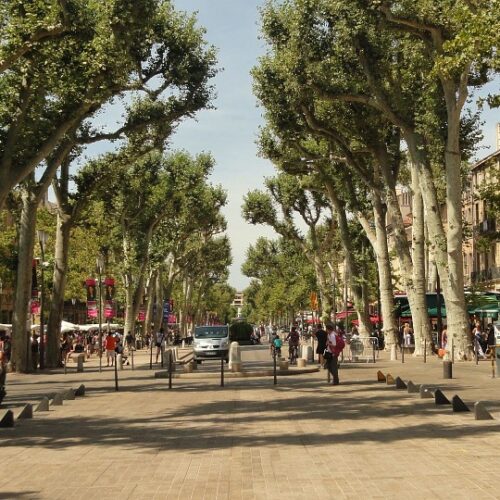
The Cours Mirabeau
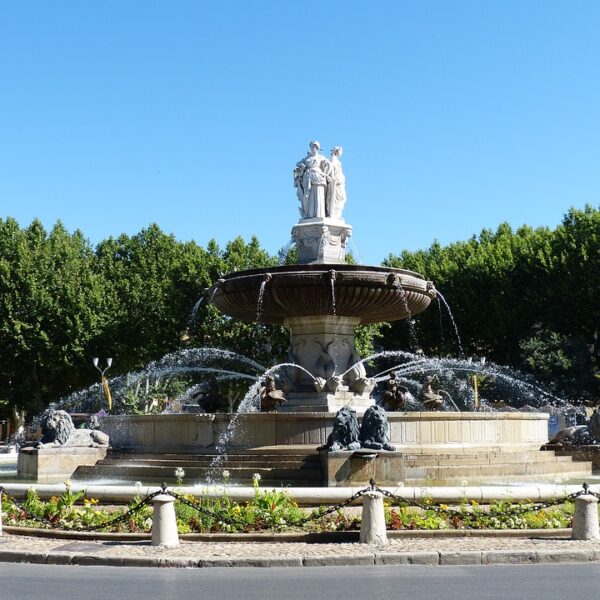
The Fountain
The Cours Mirabeau is the heart and soul of Aix-en-Provence. This wide, tree-lined avenue stretches for about one kilometer and is flanked by impressive 17th and 18th-century mansions. Walking along the Cours Mirabeau, you’ll be greeted by the grandeur of these elegant buildings, many of which have been converted into high-end boutiques, charming cafés, and upscale hotels.
The avenue takes its name from Honoré Gabriel Riqueti, comte de Mirabeau, a prominent figure during the French Revolution. As you stroll along, you’ll encounter beautifully restored fountains, such as the Fontaine de la Rotonde, adorned with statues and providing a tranquil atmosphere. The Cours Mirabeau is also renowned for its vibrant terraces, where locals and visitors gather to enjoy a leisurely coffee or a glass of wine while taking in the ambiance of this picturesque setting.
One of the notable landmarks on the Cours Mirabeau is the Church of Saint-Jean-de-Malte. This Gothic-style church dates back to the 13th century and features a stunning portal adorned with intricate sculptures. Its interior boasts beautiful stained glass windows and a tranquil atmosphere, inviting visitors to reflect and admire the religious art.
Adjacent to the Cours Mirabeau lies the charming Medieval district, also known as the Quartier Mazarin. This area transports you back in time with its narrow, winding streets, hidden squares, and architectural gems. It was developed in the 17th century by Archbishop Michel Mazarin, uncle of the famous Cardinal Mazarin, who sought to create a neighborhood of grand residences for the city’s elite.
The Medieval district is a treasure trove of historic buildings, many of which have been converted into museums, art galleries, and quaint shops. One of the highlights is the Hôtel de Caumont, an exquisite hôtel particulier that houses an art center. Its ornate facade and beautifully landscaped gardens are a testament to the grandeur of the era.
While exploring this district, don’t miss the opportunity to visit the Place des Quatre Dauphins, a delightful square adorned with a fountain featuring four playful dolphins. It’s a tranquil spot to take a break and soak in the peaceful ambiance.
Another notable attraction in the Medieval district is the Church of Saint-Jean-de-Malte, which we mentioned earlier. Its proximity to the Cours Mirabeau and its impressive architecture make it a must-visit.
As you wander through the narrow streets of the Medieval district, you’ll come across charming boutiques, art galleries, and traditional Provençal crafts shops. It’s the perfect place to find unique souvenirs, handmade ceramics, and locally produced products.
In conclusion, the Cours Mirabeau and the Medieval district in Aix-en-Provence offer a captivating blend of history, architecture, and charming ambiance. They are must-visit areas that showcase the city’s rich heritage and provide an enchanting experience for all who explore them.
Things to do in Aix en Provence : Explore the Saint Sauveur cathedral
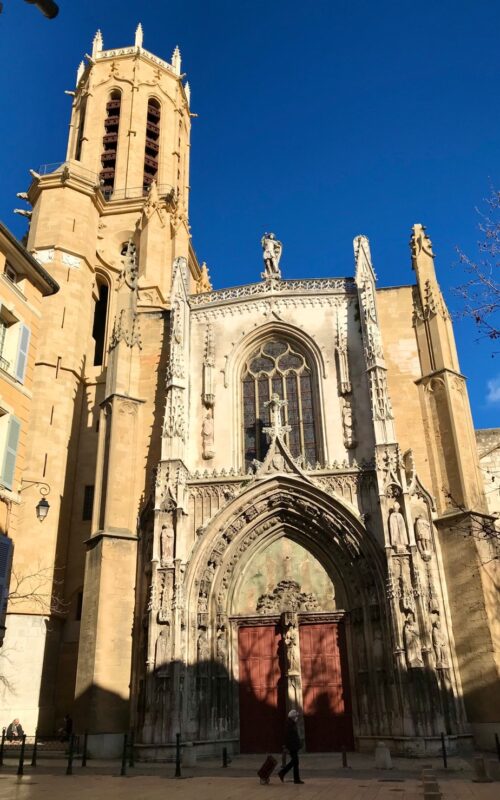
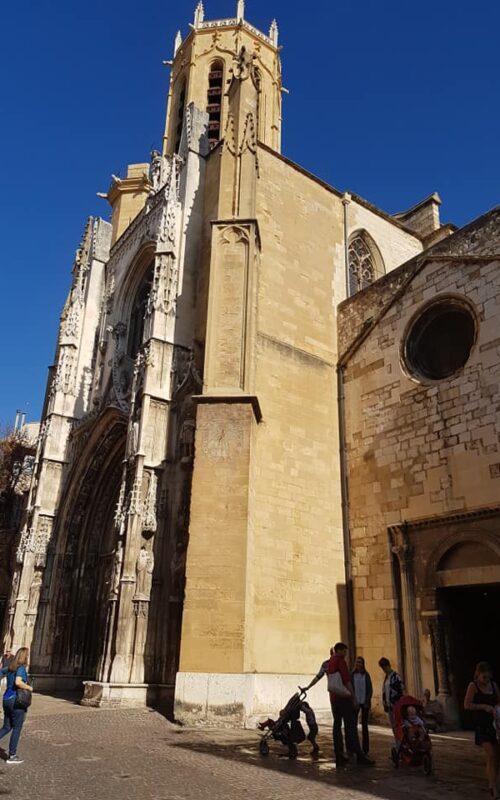
Located in the heart of Aix-en-Provence, the Cathedral of Saint Sauveur, also known as Aix Cathedral, is a masterpiece that seamlessly blends elements of Romanesque and Gothic architecture. Its construction began in the 5th century on the site of a former Roman forum and underwent numerous expansions and renovations over the centuries, resulting in the stunning structure we see today.
As you approach the cathedral, you’ll be struck by its imposing presence and the intricate details of its facade. The grand entrance showcases a beautiful blend of sculpted Romanesque decorations and Gothic arches, demonstrating the evolution of architectural styles over time. Above the main portal, you’ll find an ornate rose window that floods the interior with soft, colorful light.
Step inside, and you’ll be greeted by a breathtaking interior that exudes a sense of reverence and awe. The nave, with its soaring vaulted ceilings and graceful arches, creates a feeling of spaciousness and grandeur. The stained glass windows, dating from the 12th to the 16th centuries, depict biblical scenes and saints, casting a kaleidoscope of colors onto the stone walls.
The cathedral houses several chapels, each with its unique character and artistic treasures. One of the most notable is the Chapel of the Holy Sacrament, adorned with beautiful 17th-century marble altarpieces and a stunning baroque organ. The Chapel of Saint Catherine, dedicated to the patron saint of Aix-en-Provence, features exquisite frescoes and sculptures that depict her life and martyrdom.
One of the highlights of the Saint Sauveur Cathedral is its ancient baptistery, dating back to the 5th century. This octagonal structure is one of the oldest of its kind in France and is a testament to the early Christian roots of Aix-en-Provence. The baptistery is adorned with intricate carvings and a beautiful dome, creating a serene and intimate space for reflection.
Throughout its history, the Saint Sauveur Cathedral has witnessed numerous historical events and has been a focal point of religious and cultural life in Aix-en-Provence. From royal coronations to religious processions, this cathedral has played a significant role in shaping the identity and heritage of the city.
Today, the Cathedral of Saint Sauveur continues to serve as an active place of worship, hosting religious ceremonies, concerts, and cultural events. It stands as a symbol of faith, artistic expression, and architectural brilliance, inviting visitors to marvel at its beauty and contemplate the spiritual legacy it represents.
In conclusion, the Saint Sauveur Cathedral in Aix-en-Provence is a true architectural masterpiece that captivates with its blend of Romanesque and Gothic styles. Its rich history, awe-inspiring interior, and cultural significance make it an essential destination for anyone visiting this charming city.
Things to do in Aix en Provence : Taste local products
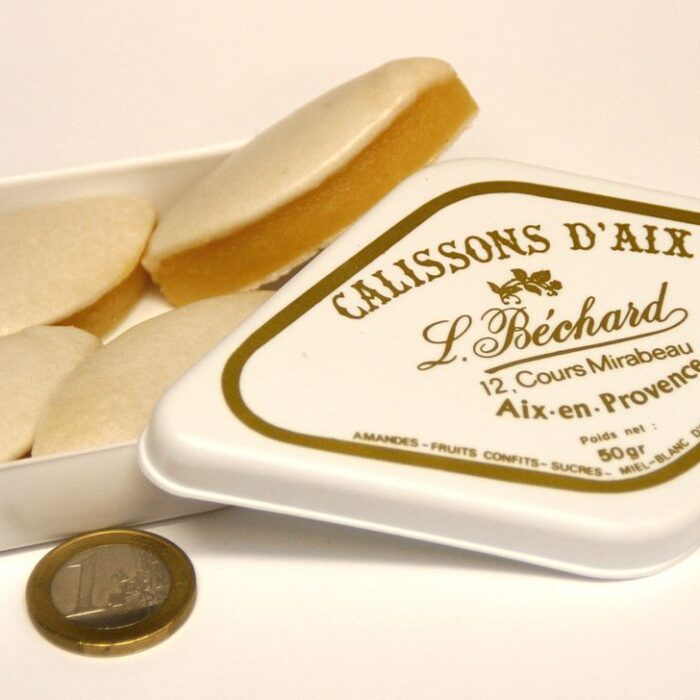

Aix-en-Provence is renowned for its rich culinary heritage, and the city boasts several specialties that are beloved by locals and visitors alike. Let me introduce you to some of the delightful specialties from Aix-en-Provence:
Calisson: This iconic sweet treat is perhaps the most famous specialty of Aix-en-Provence. Calissons are almond-shaped candies made from a paste of ground almonds, candied melon, and orange peel, flavored with a hint of orange blossom water, and topped with a thin layer of royal icing. They are a delicate balance of sweetness and subtle flavors, making them a favorite souvenir or gift from the region.
Tapenade: Tapenade is a flavorful olive paste made from black olives, capers, anchovies, garlic, and olive oil. It is typically enjoyed as a spread on crusty bread or as a condiment to enhance the flavors of various dishes. Aix-en-Provence is known for its high-quality olives, making the tapenade from the region particularly delicious and sought after.
Herbes de Provence: Aix-en-Provence is located in the heart of Provence, a region famous for its aromatic herbs. Herbes de Provence is a blend of dried herbs that typically includes thyme, rosemary, oregano, marjoram, and savory. This fragrant mixture is used to season meats, poultry, vegetables, and even baked goods, adding a touch of the Provençal countryside to any dish.
Bouillabaisse: While bouillabaisse is more commonly associated with Marseille, Aix-en-Provence is just a stone’s throw away from the coastal city, and its culinary influence extends to Aix. Bouillabaisse is a traditional Provençal fish stew made with a variety of local fish, shellfish, vegetables, and aromatic herbs, cooked in a flavorful broth. It is a delightful and hearty dish that showcases the bounty of the Mediterranean Sea.
Ratatouille: Ratatouille is a classic Provençal vegetable stew that originated in the region. It is made with a medley of seasonal vegetables such as eggplant, zucchini, bell peppers, onions, and tomatoes, cooked slowly together with herbs and olive oil. Ratatouille is a versatile dish that can be served as a side dish, a main course, or even as a filling for tarts or omelets.
Provençal Rosé Wine: Aix-en-Provence is surrounded by picturesque vineyards that produce some of the finest rosé wines in the world. The region’s dry and sunny climate lends itself well to the production of crisp and refreshing rosé wines, which have become a symbol of the Provençal lifestyle. Enjoy a glass of chilled rosé while savoring the flavors of Aix-en-Provence’s culinary delights.
These are just a few of the many specialties that Aix-en-Provence has to offer. The city’s cuisine is deeply rooted in the flavors of Provence, showcasing the region’s fresh ingredients, aromatic herbs, and culinary traditions. Exploring the local markets and restaurants in Aix-en-Provence is a delightful journey of taste and a true celebration of Provençal gastronomy.
Things to do in Aix en Provence : Discover the heritage of Paul Cezanne

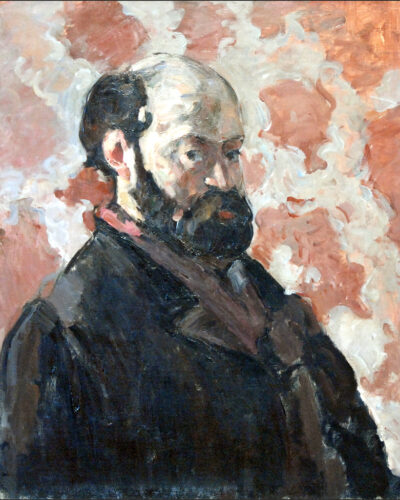
Aix-en-Provence holds a special place in the artistic heritage of one of the most celebrated painters in history, Paul Cézanne. Born in 1839 in Aix-en-Provence, Cézanne’s deep connection to the city and its surrounding landscapes influenced and shaped his artistic vision.
Cézanne’s childhood home, known as Jas de Bouffan, is located in Aix-en-Provence and played a significant role in his life and artistic development. This country estate, with its sprawling grounds and picturesque views, served as a constant source of inspiration for the young artist. Cézanne often depicted the landscapes, gardens, and objects found at Jas de Bouffan in his paintings, showcasing his intimate connection to the place where he grew up.
The city of Aix-en-Provence itself also played a significant role in Cézanne’s life and artistic journey. He attended the Collège Bourbon, now known as the Lycée Mignet, where he formed lifelong friendships with fellow students who would later become influential figures in art and literature. Despite his initial desire to pursue a career in law, Cézanne eventually decided to follow his passion for art, much to the disappointment of his father.
Throughout his career, Cézanne frequently returned to Aix-en-Provence, finding inspiration in the city’s vibrant streets, charming architecture, and enchanting landscapes. His paintings captured the essence of the Provençal countryside, with its rolling hills, picturesque villages, and distinctive light. The famous Mont Sainte-Victoire, a prominent feature in many of his works, became an iconic symbol of Cézanne’s art and his deep connection to the region.
Aix-en-Provence itself has honored Cézanne’s legacy by preserving several sites associated with the artist. The Atelier Cézanne, located on the outskirts of the city, was once the studio where he worked during the latter part of his life. It remains virtually unchanged, allowing visitors to step into Cézanne’s world and gain insight into his artistic process.
Another significant site is the Musée Granet, which houses an extensive collection of Cézanne’s works, along with other notable artists. The museum provides a comprehensive overview of Cézanne’s artistic evolution, showcasing his mastery of color, form, and composition.
Aix-en-Provence also hosts an annual festival called “Les Rencontres du 9e Art,” dedicated to comic art, where Cézanne’s influence is often celebrated and explored through exhibitions and events.
In conclusion, Aix-en-Provence holds a profound heritage of Paul Cézanne, one of the most influential painters of the 19th and early 20th centuries. From his childhood home at Jas de Bouffan to the landscapes that inspired him, Aix-en-Provence shaped Cézanne’s artistic vision and continues to honor his legacy through sites, museums, and cultural events. Exploring the heritage of Cézanne in Aix-en-Provence offers a unique opportunity to delve into the world of this remarkable artist and gain a deeper understanding of his profound connection to the region.

